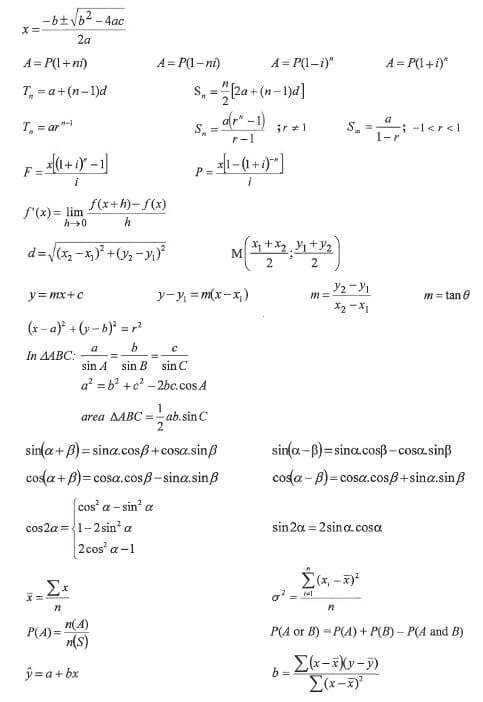MATHEMATICS PAPER 1 GRADE 12 QUESTIONS - NSC EXAMS PAST PAPERS AND MEMOS NOVEMBER 2018
Share via Whatsapp Join our WhatsApp Group Join our Telegram GroupMATHEMATICS
PAPER 1
GRADE 12
NSC EXAMS
PAST PAPERS AND MEMOS NOVEMBER 2018
INSTRUCTIONS AND INFORMATION
Read the following instructions carefully before answering the questions.
- This question paper consists of 12 questions.
- Answer ALL the questions.
- Number the answers correctly according to the numbering system used in this question paper.
- Clearly show ALL calculations, diagrams, graphs, etc. that you have used in determining your answers.
- Answers only will NOT necessarily be awarded full marks.
- You may use an approved scientific calculator (non-programmable and non-graphical), unless stated otherwise.
- If necessary, round off answers to TWO decimal places, unless stated otherwise.
- Diagrams are NOT necessarily drawn to scale.
- An information sheet with formulae is included at the end of the question paper.
- Write neatly and legibly.
QUESTIONS
QUESTION 1
1.1 Solve for x:
1.1.1 x2-4x+3=0 (3)
1.1.2 5x2 - 5x +1= 0 (correct to TWO decimal places) (3)
1.1.3 x2 - 3x-10 > 0 (3)
1.1.4 3√x = x - 4 (4)
1.2 Solve simultaneously for x and y: 3x - y = 2 and 2y + 9x2 = -1 (6)
1.3 If 39x = 64 and 5√p = 64 , calculate, WITHOUT the use of a calculator, the value of: ![]() (4) [23]
(4) [23]
QUESTION 2
2.1 Given the quadratic sequence: 2 ; 3 ; 10 ; 23 ;
2.1.1 Write down the next term of the sequence. (1)
2.1.2 Determine the nth term of the sequence. (4)
2.1.3 Calculate the 20th term of the sequence. (2)
2.2 Given the arithmetic sequence: 35 ; 28 ; 21 ; Calculate which term of the sequence will have a value of -140. (3)
2.3 For which value of n will the sum of the first n terms of the arithmetic sequence in QUESTION 2.2 be equal to the nth term of the quadratic sequence in QUESTION 2.1? (6) [16]
QUESTION 3
A geometric series has a constant ratio of ½ and a sum to infinity of 6.
3.1 Calculate the first term of the series. (2)
3.2 Calculate the 8th term of the series. (2)
3.3 ![]() . Calculate the value of n. (4)
. Calculate the value of n. (4)
3.4 ![]() in terms of p. (3)[11]
in terms of p. (3)[11]
QUESTION 4
In the diagram below, the graph of f (x) = ax2 is drawn in the interval x 0. The graph of f -1 is also drawn. P(-6 ; -12) is a point on f and R is a point on f -1.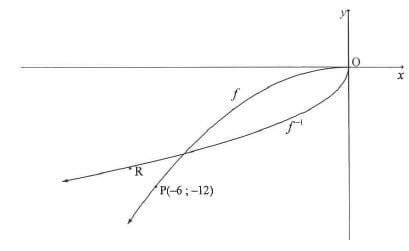
4.1 Is f-1 a function? Motivate your answer. (2)
4.2 If R is the reflection of P in the line y = x , write down the coordinates of R.(1)
4.3 Calculate the value of a.(2)
4.4 Write down the equation of f-1 in the form y = ... (3)[8]
QUESTION 5
Given: f(x)= -1
x - 1
5.1 Write down the domain of f. (1)
5.2 Write down the asymptotes of f . (2)
5.3 Sketch the graph of f clearly showing all intercepts with the axes and any asymptotes. (3)
5.4 For which values of x will x.f1 (x) 0 ? (2) [8]
QUESTION 6
In the diagram below, A and B are the x-intercepts of the graph of f (x) = x2 - 2x - 3 . A straight line, g, through A cuts f at C(4 ; 5) and the y-axis at (0 ; 1). M is a point on f and N is a point on g such that MN is parallel to the y-axis. MN cuts the x-axis at T.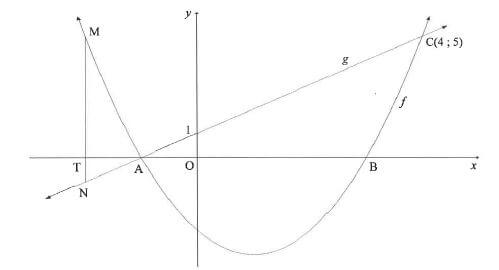
6.1 Show that g(x) = x + 1. (2)
6.2 Calculate the coordinates of A and B. (3)
6.3 Determine the range of f (3)
6.4 If MN = 6:
6.4.1 Determine the length of OT if T lies on the negative x-axis. Show ALL
your working. (4)
6.4.2 Hence, write down the coordinates of N. (2)
6.5 Determine the equation of the tangent to f drawn parallel to g (5)
6.6 For which value(s) of k will f (x) = x2 - 2x - 3 and h(x) = x + k NOT intersect? (1) [20]
QUESTION 7
7.1 Selby decided today that he will save R15 000 per quarter over the next four years. He will make the first deposit into a savings account in three months' time and he will make his last deposit at the end of four years from now.
7.1.1 How much will Selby have at the end of four years if interest is earned at 8,8% per annum, compounded quarterly? (3)
7.1.2 If Selby decides to withdraw R100 000 from the account at the end of three years from now, how much will he have in the account at the end of four years from now? (3)
7.2 Tshepo takes out a home loan over 20 years to buy a house that costs R1 500 000.
7.2.1 Calculate the monthly instalment if interest is charged at 10,5% p.a., compounded monthly. (4)
7.2.2 Calculate the outstanding balance immediately after the 144th payment was made. (5) [15]
QUESTION 8
8.1 Determine fI(x) from first principles if it is given f (x) = x2 - 5. (5)
8.2 Determine dy if : (3)
dx
8.2.1 y = 3x3 + 6x2 + x - 4 (3)
8.2.2 yx - y = 2x2 - 2x ; x # 1 (4) [12]
QUESTION 9
9.1 The graph of g(x) = x3 + bx2 + cx + d is sketched below. The graph of g intersects the x-axis at (-5 ; 0) and at P, and the y-axis at (0 ; 20). P and R are turning points of g.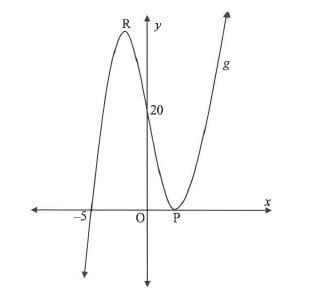
9.1.1 Show that b =1, c= -16 and d= 20. (4)
9.1.2 Calculate the coordinates of P and R. (5)
9.1.3 Is the graph concave up or concave down at (0 ; 20)? Show ALL your calculations. (3)
9.2 If g is a cubic function with:
- g(3) = gI(3) = 0
- g(0) = 27
- gII(x)> 0 when x < 3 and gII(x)< 0 when x > 3, draw a sketch graph of g indicating ALL relevant points. (3) [15]
QUESTION 10
In Δ ABC:
- D is a point on AB, E is a point on AC and F is a point on BC such that DECF is a parallelogram.
- BF : FC = 2 : 3.
- The perpendicular height AG is drawn intersecting DE at H.
- AG = t units.
- BC = (5 — t) units.
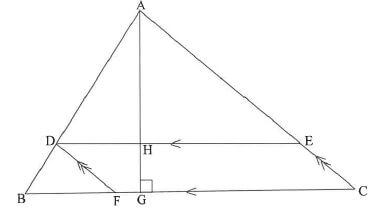
10.1 Write down All : HG. (1)
10.2 Calculate t if the area of the parallelogram is a maximum. (NOTE: Area of a parallelogram = base x ⊥ height)
QUESTION 11
Given the digits: 3 ; 4 ; 5 ; 6 ; 7 ; 8 and 9
11.1 Calculate how many unique 5-digit codes can be formed using the digits above, if:
11.1.1 The digits may be repeated (2)
11.1.2 The digits may not be repeated (2)
11.2 How many unique 3-digit codes can be formed using the above digits, if:
- Digits may be repeated
- The code is greater than 400 but less than 600
- The code is divisible by 5 (3) [17]
QUESTION 12
12.1 Given: P(A) = 0,45; P(B) = y and P(A or B) = 0,74. Determine the value(s) of y if A and B are mutually exclusive. (3)
12.2 An organisation decided to distribute gift bags of sweets to a Grade R class at a certain school. There is a mystery gift in exactly ¼ of the total number of bags.
Each learner in the class may randomly select two gift bags of sweets, one after the other. The probability that a learner selects two bags of sweets with a mystery gift is 7/118 . Calculate the number of gift bags of sweets with a mystery gift inside. (6) [91
TOTAL: 150
